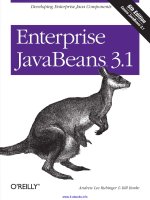OReilly enterprise javabeans 3 0 5th edition may 2006 ISBN 059600978x
Bạn đang xem bản rút gọn của tài liệu. Xem và tải ngay bản đầy đủ của tài liệu tại đây (7.32 MB, 1,380 trang )
EnterpriseJavaBeans,3.0
ByBillBurke,RichardMonson-Haefel
...............................................
Publisher:O'Reilly
PubDate:May16,2006
PrintISBN-10:0-596-00978-X
Pages:760
TableofContents|Index
EnterpriseJavaBeans,3.0
ByBillBurke,RichardMonson-Haefel
...............................................
Publisher:O'Reilly
PubDate:May16,2006
PrintISBN-10:0-596-00978-X
Pages:760
TableofContents|Index
Copyright
Dedication
Foreword
Preface
PartPARTI:TheEJB3.0Standard
Chapter1.Introduction
Section1.1.Server-SideComponents
Section1.2.PersistenceandEntityBeans
Section1.3.AsynchronousMessaging
Section1.4.WebServices
Section1.5.TitanCruises:AnImaginaryBusiness
Section1.6.What'sNext?
Chapter2.ArchitecturalOverview
Section2.1.TheEntityBean
Section2.2.TheEnterpriseBeanComponent
Section2.3.UsingEnterpriseandEntityBeans
Section2.4.TheBean-ContainerContract
Section2.5.Summary
Chapter3.ResourceManagementandPrimaryServices
Section3.1.ResourceManagement
Section3.2.PrimaryServices
Section3.3.What'sNext?
Chapter4.DevelopingYourFirstBeans
Section4.1.DevelopinganEntityBean
Section4.2.DevelopingaSessionBean
Chapter5.Persistence:EntityManager
Section5.1.EntitiesArePOJOs
Section5.2.ManagedVersusUnmanagedEntities
Section5.3.PackagingaPersistenceUnit
Section5.4.ObtaininganEntityManager
Section5.5.InteractingwithanEntityManager
Section5.6.ResourceLocalTransactions
Chapter6.MappingPersistentObjects
Section6.1.TheProgrammingModel
Section6.2.BasicRelationalMapping
Section6.3.PrimaryKeys
Section6.4.PropertyMappings
Section6.5.MultitableMappingswith@SecondaryTable
Section6.6.@EmbeddedObjects
Chapter7.EntityRelationships
Section7.1.TheSevenRelationshipTypes
Section7.2.MappingCollection-BasedRelationships
Section7.3.DetachedEntitiesandFetchType
Section7.4.Cascading
Chapter8.EntityInheritance
Section8.1.SingleTableperClassHierarchy
Section8.2.TableperConcreteClass
Section8.3.TableperSubclass
Section8.4.MixingStrategies
Section8.5.NonentityBaseClasses
Chapter9.QueriesandEJBQL
Section9.1.QueryAPI
Section9.2.EJBQL
Section9.3.NativeQueries
Section9.4.NamedQueries
Chapter10.EntityCallbacksandListeners
Section10.1.CallbackEvents
Section10.2.CallbacksonEntityClasses
Section10.3.EntityListeners
Chapter11.SessionBeans
Section11.1.TheStatelessSessionBean
Section11.2.SessionContext
Section11.3.TheLifeCycleofaStatelessSessionBean
Section11.4.TheStatefulSessionBean
Section11.5.TheLifeCycleofaStatefulSessionBean
Section11.6.StatefulSessionBeansandExtendedPersistenceContexts
Section11.7.NestedStatefulSessionBeans
Chapter12.Message-DrivenBeans
Section12.1.JMSandMessage-DrivenBeans
Section12.2.JMS-BasedMessage-DrivenBeans
Section12.3.TheLifeCycleofaMessage-DrivenBean
Section12.4.Connector-BasedMessage-DrivenBeans
Section12.5.MessageLinking
Chapter13.TimerService
Section13.1.Titan'sMaintenanceTimer
Section13.2.TimerServiceAPI
Section13.3.Transactions
Section13.4.StatelessSessionBeanTimers
Section13.5.Message-DrivenBeanTimers
Section13.6.FinalWords
Chapter14.TheJNDIENCandInjection
Section14.1.TheJNDIENC
Section14.2.ReferenceandInjectionTypes
Chapter15.Interceptors
Section15.1.InterceptingMethods
Section15.2.InterceptorsandInjection
Section15.3.InterceptingLifeCycleEvents
Section15.4.ExceptionHandling
Section15.5.InterceptorLifeCycle
Section15.6.BeanClass@AroundInvokeMethods
Section15.7.FutureInterceptorImprovements
Chapter16.Transactions
Section16.1.ACIDTransactions
Section16.2.DeclarativeTransactionManagement
Section16.3.IsolationandDatabaseLocking
Section16.4.NontransactionalEJBs
Section16.5.ExplicitTransactionManagement
Section16.6.ExceptionsandTransactions
Section16.7.TransactionalStatefulSessionBeans
Section16.8.ConversationalPersistenceContexts
Chapter17.Security
Section17.1.AuthenticationandIdentity
Section17.2.Authorization
Section17.3.TheRunAsSecurityIdentity
Section17.4.ProgrammaticSecurity
Chapter18.EJB3.0:WebServicesStandards
Section18.1.WebServicesOverview
Section18.2.XMLSchemaandXMLNamespaces
Section18.3.SOAP1.1
Section18.4.WSDL1.1
Section18.5.UDDI2.0
Section18.6.FromStandardstoImplementation
Chapter19.EJB3.0andWebServices
Section19.1.AccessingWebServiceswithJAX-RPC
Section19.2.DefiningaWebServicewithJAX-RPC
Section19.3.UsingJAX-WS
Section19.4.OtherAnnotationsandAPIs
Chapter20.JavaEE
Section20.1.Servlets
Section20.2.JavaServerPages
Section20.3.WebComponentsandEJB
Section20.4.FillingintheGaps
Section20.5.FittingthePiecesTogether
Chapter21.EJBDesignintheRealWorld
Section21.1.Predesign:ContainersandDatabases
Section21.2.Design
Section21.3.ShouldYouUseEJBs?
Section21.4.WrappingUp
PartPARTII:TheJBossWorkbook
Introduction
Section22.1.ContentsoftheJBossWorkbook
ChapterWORKBOOK1.JBossInstallationandConfiguration
Section23.1.AboutJBoss
Section23.2.InstallingtheJBossApplicationServer
Section23.3.AQuickLookatJBossInternals
Section23.4.ExerciseCodeSetupandConfiguration
ChapterWORKBOOK2.ExercisesforChapter4
Section24.1.Exercise4.1:YourFirstBeanswithJBoss
Section24.2.Exercise4.2:JNDIBindingwithAnnotations
Section24.3.Exercise4.3:JNDIBindingwithXML
ChapterWORKBOOK3.ExercisesforChapter5
Section25.1.Exercise5.1:InteractingwithEntityManager
Section25.2.Exercise5.2:StandalonePersistence
ChapterWORKBOOK4.ExercisesforChapter6
Section26.1.Exercise6.1:BasicPropertyMappings
Section26.2.Exercise6.2:@IdClass
Section26.3.Exercise6.3:@EmbeddedId
Section26.4.Exercise6.4:MultitableMappings
Section26.5.Exercise6.5:EmbeddableClasses
ChapterWORKBOOK5.ExercisesforChapter7
Section27.1.Exercise7.1:Cascading
Section27.2.Exercise7.2:InverseRelationships
Section27.3.Exercise7.3:LazyInitialization
ChapterWORKBOOK6.ExercisesforChapter8
Section28.1.Exercise8.1:SingleTableperHierarchy
Section28.2.Exercise8.2:SingleTableperHierarchy
Section28.3.Exercise8.3:JOINEDInheritanceStrategy
ChapterWORKBOOK7.ExercisesforChapter9
Section29.1.Exercise9.1:QueryandEJBQLBasics
ChapterWORKBOOK8.ExercisesforChapter10
Section30.1.Exercise10.1:EntityCallbacks
Section30.2.Exercise10.2:EntityListeners
ChapterWORKBOOK9.ExercisesforChapter11
Section31.1.Exercise11.1:StatelessSessionBean
Section31.2.Exercise11.2:XMLOverride
Section31.3.Exercise11.3:AnnotationlessStatelessSessionBean
Section31.4.Exercise11.4:StatefulSessionBean
Section31.5.Exercise11.5:AnnotationlessStatefulSessionBean
ChapterWORKBOOK10.ExercisesforChapter12
Section32.1.Exercise12.1:TheMessage-DrivenBean
ChapterWORKBOOK11.ExercisesforChapter13
Section33.1.Exercise13.1:EJBTimerService
ChapterWORKBOOK12.ExercisesforChapter15
Section34.1.Exercise15.1:EJBInterceptors
Section34.2.Exercise15.2:InterceptingEJBCallbacks
ChapterWORKBOOK13.ExercisesforChapter16
Section35.1.Exercise16.1:ConversationalPersistenceContexts
ChapterWORKBOOK14.ExercisesforChapter17
Section36.1.Exercise17.1:Security
Section36.2.Exercise17.2:SecuringThroughXML
ChapterWORKBOOK15.ExercisesforChapter19
Section37.1.Exercise19.1:ExposingaStatelessBean
Section37.2.Exercise19.2:Usinga.NETClient
PartPARTIII:Appendix
JBossDatabaseConfiguration
SectionA.1.SetUptheDatabase
SectionA.2.Examinethepersistence.xmlFile
SectionA.3.StartUpJBoss
SectionA.4.BuildandDeploytheExamplePrograms
SectionA.5.ExamineandRuntheClientApplications
AbouttheAuthors
Colophon
Index
EnterpriseJavaBeans™3.0,FifthEdition
byBillBurkeandRichardMonson-Haefel
Copyright©2006,2004,2001,2000,1999O'ReillyMedia,Inc.
Allrightsreserved.
PrintedintheUnitedStatesofAmerica.
PublishedbyO'ReillyMedia,Inc.,1005GravensteinHighway
North,Sebastopol,CA95472.
O'Reillybooksmaybepurchasedforeducational,business,or
salespromotionaluse.Onlineeditionsarealsoavailablefor
mosttitles(safari.oreilly.com).Formoreinformation,contact
ourcorporate/institutionalsalesdepartment:(800)998-9938or
Editor:
MikeLoukides
ProductionEditor:
ColleenGorman
Copyeditor:
AudreyDoyle
Proofreaders:
MattHutchinsonandRachelMonaghan
Indexer:
JulieHawks
CoverDesigner:
HannaDyer
InteriorDesigner:
DavidFutato
Illustrators:
RobertRomanoandJessamynRead
PrintingHistory:
June1999:
FirstEdition.
March2000:
SecondEdition.
September2001:
ThirdEdition.
June2004:
FourthEdition.
May2006:
FifthEdition.
NutshellHandbook,theNutshellHandbooklogo,andthe
O'ReillylogoareregisteredtrademarksofO'ReillyMedia,Inc.
EnterpriseJavaBeans™,FifthEdition,theimageofawallaby
andjoey,andrelatedtradedressaretrademarksofO'Reilly
Media,Inc.
Java™andallJava-basedtrademarksandlogosaretrademarks
orregisteredtrademarksofSunMicrosystems,Inc.,inthe
UnitedStatesandothercountries.O'ReillyMedia,Inc.is
independentofSunMicrosystems.Microsoft,Windows,
WindowsNT,andtheWindowslogoaretrademarksor
registeredtrademarksofMicrosoftCorporationintheUnited
Statesandothercountries.JBossisfullyownedandoperated
byJBoss,Inc.intheUnitedStatesandothercountries.
Manyofthedesignationsusedbymanufacturersandsellersto
distinguishtheirproductsareclaimedastrademarks.Where
thosedesignationsappearinthisbook,andO'ReillyMedia,Inc.
wasawareofatrademarkclaim,thedesignationshavebeen
printedincapsorinitialcaps.
Whileeveryprecautionhasbeentakeninthepreparationofthis
book,thepublisherandauthorsassumenoresponsibilityfor
errorsoromissions,orfordamagesresultingfromtheuseof
theinformationcontainedherein.
ISBN:0-596-00978-X
[M]
Dedication
Formygirls:Monica,Molly,Abby,andWinnie
BillBurke
Formywifeandbestfriend,Hollie
RichardMonson-Haefel
Foreword
EnterpriseJavaBeans™isthecorecomponenttechnologyofthe
JavaEnterpriseEditionplatform.Itisanenterprise
infrastructuredesignedtoprovidedeveloperswiththe
automaticmanagementofmanyoftheservicesessentialto
enterpriseapplications.TheEJBcontainertheimmediate
environmentofenterprisebeancomponentsandtheproviderof
managedservicestothemisatthecenterofthisarchitecture.
However,tousethismanagedenvironmentinearlierversions
ofEJB,developershadtowritetoAPIsthatfocusedmoreon
theEJBcontainer'srequirementsthanonthebusinesslogicof
enterpriseapplications.Consequently,EJBdevelopmentwas
unnecessarilycomplex.Forexample:
ImplementationofvariousEJBinterfacesledtoalotof
boilerplatecodeformethodsthatwererequiredbythe
interface,butnotneededbytheapplication.
AnXMLdeploymentdescriptorwasrequiredtointegratethe
applicationwithitsenvironmentandwithcontainer
services.Accesstothecomponents'environmentwas
clumsyandnonintuitive.
Thedesignofcontainer-managedpersistencemadedomain
objectmodelingunnecessarilycomplexandheavyweight.
Whilecontainer-managedpersistencewasoriginally
conceivedasanease-of-usefacility,inpractice,itwas
awkwardandlimiting.
ThepurposeoftheEJB3.0releasewastorefocusEJBon
simplifyingthedeveloper'stasksandtofixalloftheseproblems,
andmore.
Oneofthefirststepsinthisprocesswasevaluatingthesources
ofcomplexityintheearlierEJBreleases.Thisinvolved
examiningcriticismsofEJB;understandingwhichEJBdesign
patternswerereallyantipatterns;identifyingAPIsthatwere
clumsytouse,werenonintuitivetonewcomerstothe
technology,orcouldbedispensedwithentirely;andrecognizing
otheraspectsofthetechnologythatwereobstaclestoeaseof
use.
Thepreliminarylistofwhatneededtobefixedtogetherwitha
proposalforhowthetaskcouldbeapproachedformedthebasis
ofJSR220,theJavaCommunityProcessspecificationrequest
withwhichIlaunchedEJB3.0.Startingwiththeinitiallistofthe
APIsthatneededimprovement,theEJB3.0ExpertGroup
undertooktheprocessofbrainstormingonbetter,simpler
constructs.BillBurke,thechiefarchitectoftheJBoss
applicationserverandauthorofthisbook,wasoneofthekey
participantsinthiseffort.
TheExpertGroup'sworkhasresultedinamajorsimplification
andimprovement.AllofthekeyEJBAPIsareeasiertouse,and
theconfiguration-by-exceptionapproachofEJB3.0allows
developerstorelyonexpecteddefaultbehaviors.TheXML
deploymentdescriptorhasbecomeunnecessary,exceptfor
addressingmoreadvancedcases.
TheJavalanguagemetadatafacility,newlyaddedtoJavaSE,
aidedusinmakingthesesimplifications.EJB3.0usesmetadata
annotationstoexpresswithinJavacodethedependenciesof
EJBcomponentsuponcontainerservices,andthustoavoidthe
needtoprovideadeploymentdescriptor.Further,EJB3.0
providesdefaultvaluesformetadatasothatingeneral,this
metadatacanbesparse.
Byusingmetadataannotationstodesignateenvironment
dependenciesandlifecyclecallbacks,EJB3.0hasalsobeen
abletoeliminatetherequirementforthebeanclassto
implementtotheEnterpriseBeaninterfaces.Abeanclasscan
nowselectivelyspecifywhatitneeds,andcanimplementonly
neededmethodsratherthanunnecessaryboilerplatecode.
WewereabletoeliminatetheearlierEJBHomefactorypatterns
aswellbyrequiringsmarterinterpositioningonthepartofthe
container(transparentlytotheapplication)increating
referencestocomponentsandtheirinstancesatthetimeof
lookuporinjection.Sessionbeanscannowbeprogrammedas
ordinaryJavaclasseswithordinarybusinessinterfaces,rather
thanasheavyweightcomponents.
Theseandotherchangeshavegreatlysimplifiedthedeveloper
view.Further,theyleavetheunderlyingEJBarchitecture
fundamentallyunchanged,providingamigrationpathtoEJB
3.0.
Thesimplificationofcontainer-managedpersistenceprovideda
greaterchallenge.Webegantheeffortherewiththesame
stepsasthesimplificationofsessionbeansandmessage-driven
beans:eliminationofunneededinterfaces,useofannotations
forconfigurationinformation,andsoon.Itsoonbecameclear,
however,thatEJBpersistenceneededamoreradical
transformation.Further,thesuccessoflighter-weight
object/relationalmappingtechnologiessuchasHibernategave
clearguidancetothedirectionthatthistransformationshould
take.
Asdescribedinthisbook,theresultingJavaPersistenceAPI
replacescontainer-managedpersistencewithalighter-weight,
PlainOldJavaObject(POJO)persistencelayer.Thislayer
providesextensivesupportfordomainobjectmodeling,
includinginheritanceandpolymorphism;numerous
enhancementstotheEJBQLquerylanguagetoproviderich
querycapabilities;andaspecificationforportable
object/relationalmappingthroughuseofannotationsoranXML
descriptor.Persistententitiesarenowinstancesofordinary(but
managed)Javaclasses.Assuch,theycanbecreatedwithnew
andpassedtootherapplicationtiersasordinaryJavaobjects.
ThemanagedpersistencecontextsprovidedbytheJava
PersistenceAPIprovideparticularleveragewithinEJB3.0
environments,andenabletheeasymodelingofextendedclient
"conversations."
Becauseofthescopeofthiswork,EJB3.0hasgreatlysimplified
enterpriseapplicationdevelopment,andmanyofthefeaturesit
hasintroducedhavebeenincorporatedelsewhereintheJavaEE
platform.Beyondthis,theJavaPersistenceAPIhasbeen
expandedtosupportuse"outsidethecontainer"inJavaSE
environments.
BillBurke'scontributionstoEJB3.0andtheJavaPersistence
APIhavebeennumerousandfarreaching.Aschiefarchitectfor
theJBossapplicationserver,hebroughttotheEJB3.0Expert
Groupkeyinsightsoncontainerinnovations,extensive
experiencewiththeHibernateobject/relationalpersistence
technology,andabroadperspectiveontheneedsofdevelopers
andtheiruseoftheEJBtechnologyinreal-worldapplications.
InthisneweditionofEnterpriseJavaBeans,basedonthe
earlierworkbyRichardMonson-Haefel,BillBurkesharesthese
insightstogetherwithhisin-depthperspectiveonhowthese
new,simplifiedEJB3.0APIstransformtheenterpriseJava
landscapeforapplicationdevelopers.
LindaDeMichiel
EJB3.0ArchitectandSpecificationLead
SunMicrosystems
SantaClara,California
Preface
Author'sNote
Inthespringof2000,IleftmyCORBAdevelopmentjobatIona
andwenttoasmallstartupthatwasbuildingane-marketing
portal.ComingfromaCORBAbackgroundtoanEnterprise
JavaBeans™projectwasabitalientome.Irememberthinking,
"Whydoestheserversideneedacomponentmodel?"Iquickly
learnedthatdeclarativetransaction,security,andpersistence
metadataplayedacrucialroleindevelopingbusiness
applications.
Likemanystartupsatthattime,weranintofundingproblems
attheendof2000.Wewereabouttogointobetawithourfirst
customerswhenourproblemswerecompoundedwhenour
applicationservervendorrevokedourdemolicenseand
demandedpayment.Wehadtofindafreesolutionfast,and
thatwaswhenIstumbledintotheopensourceapplication
server,JBoss.
Itdidn'ttakeverylongtoconverttoJBoss,butIfoundthat
JBoss2.0wasabitrawinsomeareas.Ihadanextensive
backgroundinwritingmiddlewareunderthetutelageofSteve
VinoskiatIona,soitwasn'ttoodifficulttojumpintothe
codebase.Iimmediatelybeganfixingbugshereandthere,
submittingpatchestotheJBossmaillist.Afterafewmonthsof
contributing,Ireceivedastrangeemail:
whatdoyoudoinreallife
TheemailwasfromJBoss'sfounder,MarcFleury.Letmetell
you,JBosswasthefirstopensourceprojectIhadever
contributedto,andreceivinganemailfromthefounderhimself
wasalmostlikereceivingamessagefromGod.OK,maybeI'm
exaggeratingabithere.Itwasmorelikereceivingacoded
messagefromMorpheusinthemovieTheMatrix.Iresponded
toMarc'semail,sayingIworkedforastrugglingstartupand
thatIhadwrittenmiddlewareatmypreviousjobatIona.Igot
aone-sentenceresponsefromMarc:
doyouwanttotaketheredpill
Iwashooked.Irepliedyes,andmyjourneydowntherabbit
holebegan.IbecameaCVScommitterandfirstworkedon
entitybeansynchronization.Laterthatyear,IhelpedSacha
LaboureyonJBoss'sfirstclusteringimplementation.Therestis
history.
Backin2002,RichardMonson-Haefel,theoriginalauthorofthe
EJBbookseries,contactedMarcaboutcontributingaJBoss
workbook.Marcwasn'tinterested,soheintroducedRichardto
SachaLaboureyandme,andwewrotetheworkbookthat
O'Reillypublishedwithitsbook,EnterpriseJavaBeans,Fourth
Edition.WhenRichardretiredfromwritinglastyear,Iguessmy
workwasgoodenoughthatO'Reillyofferedmetheopportunity
toupdatetheseriestothelatestEJB3.0specification.
WhoShouldReadThisBook
Thisbookexplainsanddemonstratesthefundamentalsofthe
EJB3.0andJavaPersistenceprogrammingmodels.Although
EJBmakesapplicationdevelopmentmuchsimpler,itisstilla
complextechnologythatrequiresagreatdealoftimeandstudy
tomaster.Thisbookprovidesastraightforward,no-nonsense
explanationoftheunderlyingtechnology,Java™classesand
interfaces,thecomponentmodel,andtheruntimebehaviorof
EJB.Itdoesnotincludematerialonpreviousversionsofthe
specification,however.
Althoughthisbookfocusesonthefundamentals,it'snota
"dummies"book.EJBisanextremelycomplexandambitious
enterprisetechnology.WhileusingEJBmaybefairlysimple,the
amountofworkrequiredtounderstandandmasterEJBis
significant.Beforereadingthisbook,youshouldbefluentinthe
Javalanguageandhavesomepracticalexperiencedeveloping
businesssolutions.Experiencewithdistributedobjectsystems
isnotamust,butyouwillneedsomeexperiencewithJDBC(or
atleastanunderstandingofthebasics)tofollowtheexamples
inthisbook.IfyouareunfamiliarwiththeJavalanguage,I
recommendLearningJava;thisbookwasformerlyExploring
Java(bothfromO'Reilly).IfyouareunfamiliarwithJDBC,I
recommendDatabaseProgrammingwithJDBCandJava
(O'Reilly).Ifyouneedastrongerbackgroundindistributed
computing,IrecommendJavaDistributedComputing(O'Reilly).
HowThisBookIsOrganized
Thisbookisorganizedintotwoparts:thetechnicalmanuscript,
followedbytheJBossworkbook.Thetechnicalmanuscript
explainswhatEJBis,howitworks,andwhentouseit.The
JBossworkbookprovidesstep-by-stepinstructionsforinstalling,
configuring,andrunningtheexamplesfromthemanuscripton
theJBoss4.0ApplicationServer.
PartI:TheEJB3.0Standard
Part1wasadaptedfromRichardMonson-Haefel'sfourthedition
ofthisbookbyyourstruly,BillBurke.LindaDeMichiel,theEJB
3.0specificationlead,wrotetheforewordtothisbook.JasonT.
GreeneadaptedChapters18and19.Hereisasummaryofthe
contentofthetechnicalmanuscriptchapters:
Chapter1,Introduction
Thischapterdefinescomponenttransactionmonitorsand
explainshowtheyformtheunderlyingtechnologyofthe
EJBcomponentmodel.
Chapter2,ArchitecturalOverview
ThischapterdefinesthearchitectureoftheEJBcomponent
modelandexaminesthedifferencesbetweenthethree
basictypesofenterprisebeans:entitybeans,session
beans,andmessage-drivenbeans.
Chapter3,ResourceManagementandPrimaryServices
ThischapterexplainshowtheEJB-compliantserver
managesanenterprisebeanatruntime.
Chapter4,DevelopingYourFirstBeans
Thischapterwalksyouthroughthedevelopmentofsome
simpleenterpriseandentitybeans.
Chapter5,Persistence:EntityManager
Thischapterexplainshowentitybeansinteractwiththe
newentitymanagerservice.
Chapter6,MappingPersistentObjects
Thischapterdefinesthebasicrelationaldatabasemapping
providedbytheJavaPersistencespecification.
Chapter7,EntityRelationships
ThischapterpicksupwhereChapter6leftoff,expanding
yourunderstandingofpersistenceandcomplexbean-tobeanrelationships.
Chapter8,EntityInheritance
Thischapterdiscussesentitybeaninheritanceandhowan
objecthierarchycanbemappedtoarelationaldatabase.
Chapter9,QueriesandEJBQL
ThischapteraddressestheEnterpriseJavaBeansQuery
Language(EJBQL),whichisusedtoqueryentitybeansand
tolocatespecificentitybeansinJavaPersistence.
Chapter10,EntityCallbacksandListeners
Thischaptercoversthelifecycleofanentitybeanandhow
youcanwriteclassesthatcaninterceptentitylifecycle
events.
Chapter11,SessionBeans
Thischaptershowshowtodevelopstatelessandstateful
sessionbeans.
Chapter12,Message-DrivenBeans
Thischaptershowshowtodevelopmessage-drivenbeans.
Chapter13,TimerService
ThischaptershowshowtousetheTimerServiceinEJB3.0.
Chapter14,TheJNDIENCandInjection
ThischapterexplainstheJNDIENCaswellasthenew
injectionannotationsandtheirXMLequivalents.
Chapter15,Interceptors
ThischapterdiscussesEJBinterceptorsandhowyoucan
usethemtoextendthebehaviorofyourEJBcontainer.
Chapter16,Transactions
Thischapterprovidesanin-depthexplanationof
transactionsanddescribesthetransactionalmodeldefined
byEJB.
Chapter17,Security
ThischapterwalksyouthroughthebasicsofEJBsecurity.
Chapter18,EJB3.0:WebServicesStandards
ThischapterexplainstheXML,SOAP,WSLD,andUDDIweb
servicesstandards.
Chapter19,EJB3.0andWebServices
ThischapterdiscusseshowtheJAX-RPCAPIsupportsweb
servicesinEJB.
Chapter20,JavaEE
ThischapterprovidesanoverviewofJavaEE5andexplains
howEJB3.0fitsintothisnewplatform.
Chapter21,EJBDesignintheRealWorld
Thischapterprovidessomebasicdesignstrategiesthatcan
simplifyyourEJBdevelopmenteffortsandmakeyourEJB
systemmoreefficient.
PartII:TheJBossWorkbook
TheJBossworkbookshowshowtoexecuteexamplesfrom
thosechaptersinthebookthatincludeatleastonesignificant
example.You'llwanttoreadtheintroductiontotheworkbook
tosetupJBossandconfigureitfortheexamples.Afterthat,
justgototheworkbookchapterthatmatchesthechapter
you'rereading.Forexample,ifyouarereadingChapter6on
mappingpersistentobjects,usethe"ExercisesforChapter6"
chapteroftheworkbooktodevelopandruntheexampleson
JBoss.
SoftwareandVersions
ThisbookcoversEJB3.0andJavaPersistence1.0.ItusesJava
languagefeaturesfromtheJavaSE5platform,includingJDBC.
BecausethefocusofthisbookisondevelopingvendorindependentEJBcomponentsandsolutions,Ihavestayedaway
fromproprietaryextensionsandvendor-dependentidioms.You
canuseanyEJB-compliantserverwiththisbook,butyou
shouldbefamiliarwithyourserver'sspecificinstallation,
deployment,andruntime-managementprocedurestoworkwith
theexamples.AworkbookfortheJBossApplicationServeris
includedattheendofthisbooktohelpyougetstarted.
ConventionsUsedinThisBook
Thefollowingtypographicalconventionsareusedinthisbook:
Italic
Usedforfilenamesandpathnames,hostnames,domain
names,URLs,andemailaddresses.Italicisalsousedfor
newtermswheretheyaredefined.
Constantwidth
Usedforcodeexamplesandfragments,XMLelementsand
tags,andSQLcommands,tablenames,andcolumnnames.
Constantwidthisalsousedforclass,variable,andmethod
namesandforJavakeywordsusedwithinthetext.
Constantwidthbold
Usedforemphasisinsomecodeexamples.
Constantwidthitalic
Usedtoindicatetextthatisreplaceable.Forexample,in
BeanNamePK,youwouldreplaceBeanNamewithaspecificbean
name.
Indicatesatip,suggestion,orgeneralnote.
Indicatesawarningorcaution.
AnEnterpriseJavaBeanconsistsofmanyparts;it'snotasingle
object,butacollectionofobjectsandinterfaces.Torefertoan
enterprisebeanasawhole,weuseitsbusinessnameinroman
type,followedbytheacronymEJB.Forexample,wewillrefer
totheTravelAgentEJBwhenwewanttotalkaboutthe
enterprisebeaningeneralandtheCustomerentitywhenwe
wanttotalkaboutentitybeans.Ifweputthenameina
constant-widthfont,wearereferringexplicitlytothebean's
interfaceorclass;thus,TRavelAgentRemoteistheremoteinterface
thatdefinesthebusinessmethodsoftheTravelAgentEJB.
UsingCodeExamples
Thisbookisheretohelpyougetyourjobdone.Ingeneral,you
mayusethecodeinthisbookinyourprogramsand
documentation.Youdonotneedtocontactusforpermission
unlessyou'rereproducingasignificantportionofthecode.For
example,writingaprogramthatusesseveralchunksofcode
fromthisbookdoesnotrequirepermission.Sellingor
distributingaCD-ROMofexamplesfromO'Reillybooksdoes
requirepermission.Answeringaquestionbycitingthisbook
andquotingexamplecodedoesnotrequirepermission.
Incorporatingasignificantamountofexamplecodefromthis
bookintoyourproduct'sdocumentationdoesrequire
permission.
Weappreciate,butdonotrequire,attribution.Anattribution
usuallyincludesthetitle,author,publisher,andISBN.For
example:"EnterpriseJavaBeans3.0,FifthEdition,byBillBurke
andRichardMonson-Haefel.Copyright2006O'ReillyMedia,
Inc.,0-596-00978-X."
Ifyoufeelyouruseofcodeexamplesfallsoutsidefairuseor
thepermissiongivenabove,feelfreetocontactusat
Safari®Enabled
WhenyouseeaSafari®enabledicononthecoverof
yourfavoritetechnologybook,thatmeansthebookisavailable
onlinethroughtheO'ReillyNetworkSafariBookshelf.
Safarioffersasolutionthat'sbetterthane-books.It'savirtual









